A Yoga Practice
In practicing asanas, all cells of the body without exception will be full of life. For that, keep your body active from the fingers to the toes. Lightness, fluidity, and circulation are there at every moment of stretching, turning, squeezing, and lifting.
The total action becomes "union" - Yoga!
Balancing Postures
1) Utthita Hasta Padangusthasana
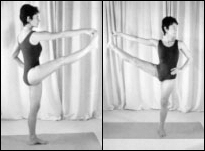 Both knees are stretched while remaining supple. Hyperextention of the knees blocks the energy and weakens the position.
Both knees are stretched while remaining supple. Hyperextention of the knees blocks the energy and weakens the position.
In this posture, it's important to stretch the abdomen and vertebral column, to keep the trunk firm and straight, to lift the leg very high. After having acquired strength, flexibility and relaxation, the posture can also be done in rotation.
2) Virabadrasana III
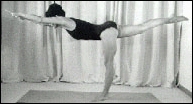
This posture is very effective to find harmony, balance, and strength. It helps us to keep our feet on the ground, maintains the stomach and abdomen toned, and gives agility to body and mind.
The trunk should be stretched and parallel to the ground. The knee of the support leg, straight and supple,the arms stretched as well.
3) Ubhaya Padangusthasana
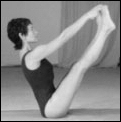
Try entering the asana from a lying position by first coming into Halasana (pictured below), then taking hold of the toes and rolling forward while keeping the legs straight.
4) Bakasana
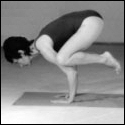
This posture works the abdomen, arms, and wrists. On an energetic level, the two first chakras are strongly stimulated and balanced bringing a sensation of confidence and security.
Stretching the Front of the Body
1) Purvottanasana

This posture improves the range-of-motion in the shoulders and opens the chest.
2) Urdhva Dhanurasana
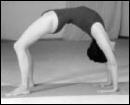
This advanced posture is very beneficial to open the shoulders, stretch the front of the body, and tonify the verebral column. It keeps the body alert and flexible and the back full of strength and vitality.
Sequence of Inverted Postures
1a) Shalamba Sarvangasana

In Lumière Sur Le Yoga, Iyengar describes the effects of this posture:
Sarvangasana has a direct effect on the thyroid and parathyroid glands due to the firm chinlock their blood supply is increased. Since the body is inverted, the venous blood flows to the heart without any strain by force of gravity. Persons suffering from breathlessness, palpitation, asthma, bronchitis and throat ailments get relief. The nerves are soothed and headaches - even chronic ones - disappear. Continued practice erradicates common colds and other nasal disturbances.
The bowels move freely and constipation vanishes. The system is freed from toxins and one feels full of energy. The asana is recommended for urinary disorders and uterine displacement, menstrual trouble, piles and hernia.
ATTENTION: People suffering from high blood pressure should not attempt Sarvangasana unless they do Halasana (pictured below) for at least 3 minutes.
1b) Viparita Karani Mudra

Here, in place of doing Shalamba Sarvangasana which can pose a problem for those suffering from neck ailments, I suggest Viparita Karani Mudra. Support yourself from the pelvis with your hands.
2) Halasana

This is the continuation of Sarvangasana. This posture brings a relief to those who suffer from shoulder stiffness, lumbago et arthritis of the back. Flatulence is reduced and one feels immediately relieved. Halasana prepares one for Paschimottanasana due to improved mobility of the back.
3) Karnapidasana

Karna means "ear", Pida means "pressure". With the knees, one exerts a pressure against the knees. This produces a big stretch of the vertebral column.
4) Matsyasana

Often, this posture is recommended as a counter-posture to Sarvangasana due to the contrary action at the level of the thyroid. Avoid, if you have a nervous tendency disposition.
Exit the posture and roll the head slowly from side to side to relax the neck muscles.
A Session
Start with Surya namaskar - Sun Salutationl. 10 times
Then the standing postures such as: Hasta Padangusthasana, Trikonasana, Parsvakonasana, Prasariti Paddotasana, Virabadrasana I, Virabadrasana II.
Continue with the balancing postures: Utthita Hastapadangusthasana (pictured above), Virabadrasana III (pictured above), Ubaya Padangusthasana, Bakasana (pictured above). (If you are advanced, continue your practice with Sirsasana, headstand with variations), then rest for several breaths in child's pose.
Lie down on your back, then come up into Salamba Sarvangasana (pictured above), 25 breaths.
End the session with Savasana (relaxation posture) for a minimum of 5 minutes. Lie comfortably on your back with the legs apart and the arms slightly away from the sides of the body, the palms of the hands face-upwards.
Bibliography
- Light on Yoga: BKS. Iyengar
- Yoga: A Gem For Women: Geetha Iyengar
- Power Yoga: Beryl Bender-Birch
- Yoga, The Iyengar Way: Silva, Mira et Shyam Mehta
- Le Yoga, Guide Complet Progressif: Centre Sivananda
- The Heart of Yoga: T.K.V. Desikachar


